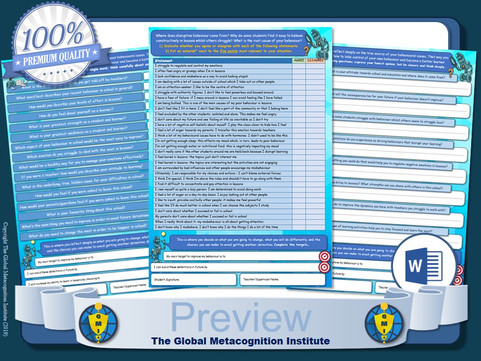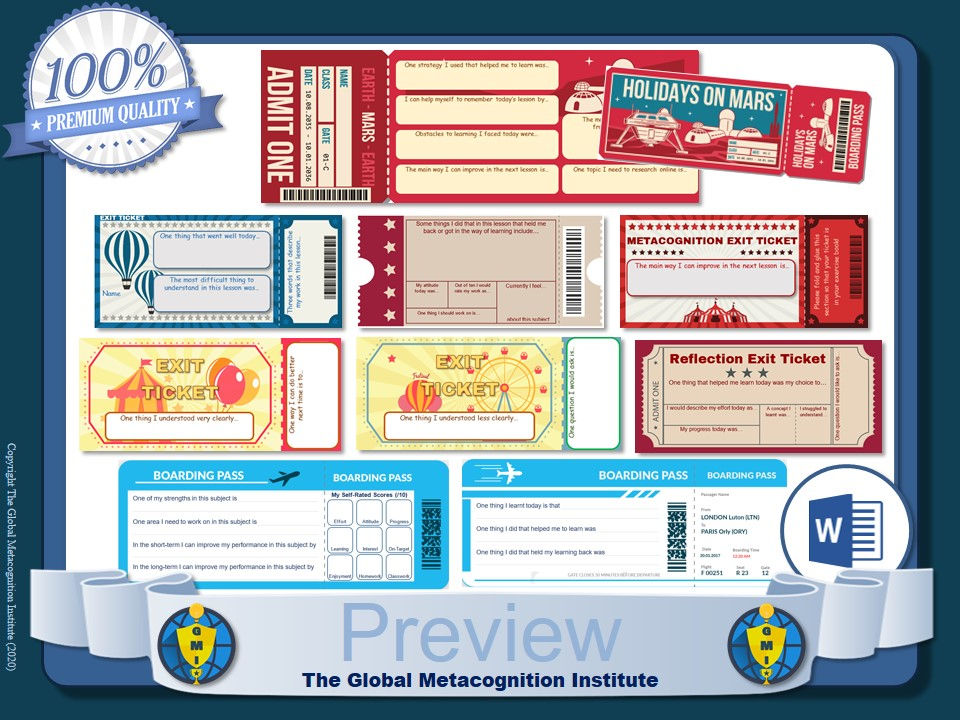Alderman & MacDonald (2015) wrote a fascinating piece of research about the use of self-regulated learning strategies for classroom management called 'A Self-Regulatory Approach to Classroom Management: Empowering Students and Teachers' where they concluded that: "Development of motivation and self-regulated learning skills can take classroom management beyond the role of maintaining order in the classroom to empower students and teachers for lifetime learning."
The authors describe self-regulated learning, student strategies, and the classroom structure that supports motivation and self-regulation. This inspired us to create a new set of ten student-reflection worksheets that will allow teachers to get more out of detentions: click here to download a free sample or download all ten by clicking here!
This article explains what 'Self-Regulated Learning' is and how the principles of self-regulated learning can be applied to student behaviour and school discipline.
What is Self-Regulated Learning?
Self-regulated learning is when students take control of their learning: it can refer to specific learning activities or their broader academic journey.
Some definitions focus on a cyclical process of planning, performance and evaluation whereby students are given time to prepare for a learning activity and time to evaluate and regulate their performance afterwards (and sometimes during). A simple example of this is the use of 'assessment wrappers' (click here to download some) or task-specific reflection activities.
There is some conceptual overlap between 'self-regulated learning' and 'metacognition': by some accounts metacognition is the cognitive (thought-based) aspect of self-regulated learning. Furthermore: many forms of self-regulation involve the regulation of beliefs, attitudes, values, motives and the like - all of which have a cognitive dimension or are, in some sense, thinking-processes.
Other definitions of self-regulated learning focus (perhaps conflate) on self-regulation for learning, for example: regulation of emotion to improve learning power, regulation of behaviour in order to enhance classroom practices, regulation of lifestyle in order to foster healthy brain development. Clearly all of these are an important part of the general remit of modern education.
Examples of Self-Regulated Learning
Examples of self-regulated learning occurring in lessons might include:
Use of lesson wrappers - where students reflect on various factors influencing their learning before and after lessons (download some here)
Use of assessment wrappers - where students reflect on their preparation and performance before and after assessments (e.g. practice exam papers) (download some here)
Task specific self-regulation, metacognition & reflection tasks (such as these worksheets)
Examples of more long-term self-regulated learning and self-regulation strategies might include:
The use of 'Personal Learning Checklists' (PLCs) - where students are given a list of topics as an overview for the required learning on a given unit of work and asked to monitor and evaluate their progress at various intervals (download)
Teaching students mindfulness and meditation strategies with a view to improving emotional self-regulation (resources here)
Teaching students about how lifestyle choices (e.g. sleep-patterns, exercise levels, diet and hydration) can influence learning-power and how best to regulate their lifestyle choices to foster healthy brain-development (resources here)
For a more comprehensive list you will find this article useful: Metacognition Activities & Strategies: The Ultimate Guide
Self-Regulated Learning and Self-Regulation: Relevance to Classroom Management, Behaviour & Discipline
Self-regulation is an important concept when it comes to classroom management for a number of reasons:
The aforementioned self-regulation cycle of planning, performance and appraisal is easily transferable to behavioural issues: consequently students can be guided to reflect on their behaviour, to analyse and evaluate it, and to regulate and change it.
Self-regulation of emotion is essential for improved behaviour since poor behaviour is often the result of poor emotional-regulation and maladaptive responses to emotional triggers.
The ability for students to take a step back which is fostered through metacognitive and self-regulated learning approaches to behaviour is useful: students should be encouraged to analyse the real causes of their behavioural issues.
Self-regulated learning theories value autonomy and student-empowerment: when transferred to the sphere of classroom management, behavioural issues and school discipline - this is a more positive way forward and avoids a number of ethical concerns with more traditional, potentially somewhat toxic, 'top-down' approaches.
Once successfully inculcated, the skills students gain from such an approach will be of long-term benefit and will have a positive influence on the rest of their lives: not just as learners but also as citizens and moral agents.
Self-regulated learning approaches to behaviour are compatible with 'Growth Mindset' models of student-development: the student should be encouraged not to see their behaviour as essential or the consequence of who they really are (e.g. "I am a rebellious person who dislikes authority figures") and more as the result of choices.
Self-regulated learning approaches to behaviour emphasise emotional understanding: this will have wider mental-health benefits for the student
Examples of Self-Regulated Learning Approaches to Behaviour & Discipline:
Examples of using self-regulated learning strategies for improved student behaviour and discipline might include:
Appropriate use of questioning in response to poor behaviour
Use of 'behaviour journals' for students with persistent behavioural issues
Use of behavioural reflection worksheets in detentions (such as these)
Interventions by school counsellors and educational psychologists whereby the student is helped to analyse, evaluate and regulate their behaviours more effectively
Teaching students about mindfulness, meditation, anger management techniques and other forms of emotional self-regulation
Helping students to identify and regulate external factors that influence their behaviour such as caffeine-consumption or a lack of sleep.
If you're interested in bringing self-regulated learning into your school or teaching practice, click here to download a free sample of our new behavioural reflection worksheets or download all ten by clicking here. They're designed for detentions and behavioural interventions and fully incorporate self-regulated learning theories.
References
M. Kay Alderman & Suzanne MacDonald (2015) A Self-Regulatory Approach to Classroom Management: Empowering Students and Teachers, Kappa Delta Pi Record, 51:2, 52-56, DOI: 10.1080/00228958.2015.1023145

























































Comments